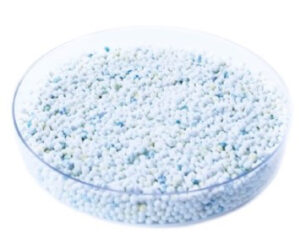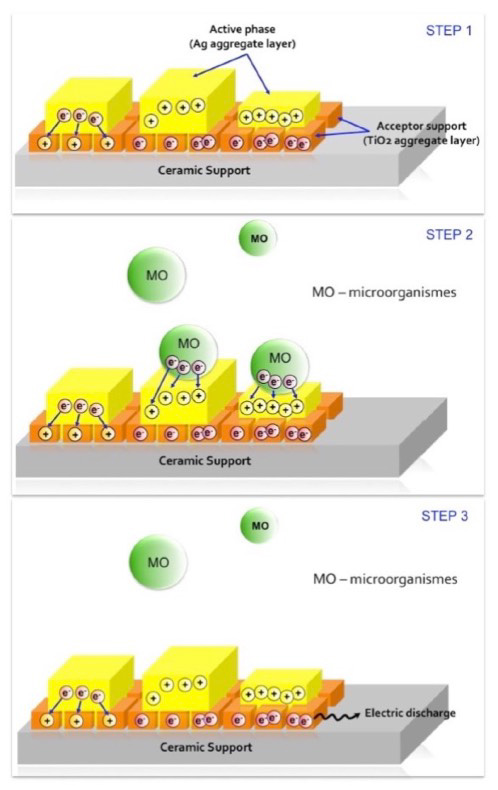Quantum Disinfection™ (QD) is a new technology that uses the quantum mechanic principles of electron movement to create catalytic active surfaces (positively charged) that can disintegrate any microorganism instantly, upon contact.
In more detail, QD refers to (1) a technology that allows the creation of (2) new composite materials with (3) particular disinfection capacities:

| Characteristic | Value |
|---|---|
| Chemical composition | Al2O3 - TiO2 - Ag |
| Shape | Sphere |
| Particle Size (mm) | Diameter: 1 - 3 |
| Particle size repartition (%: ball size) | 90 - 95%: 1.9mm <5%: 1.1mm <5%: 2.9mm |
| Average particle size (mm) | 1.9 |
| Recommended Mesh Size (mm) | 0.40 |
| Apparent density (g/cm3) | 0.75 |
A more detail description of the Quantum Disinfection™ can be found in the following related
Claire’s patents: WO2013007289 (A1), EP2729001B1, CN103997890A, CN103997890B, US2014120148 (A1), US2016257583 (A1), US9650265 (B2), CN106830232 (A)
Obviously, the germicidal capacities of the QD media are acquired due to the presence of the silver at their surface. In the same time, besides the efforts of the scientists from all over the world, the action mechanism of silver against microorganisms remains is not entirely understood. Our hypothesis for our QD silver based product is the following:
The silver at the QD surfaces is in a high cationic state (1.4 eV). This electron discharge is achieved due to the presence of the TiO2 layer which, in the QD spacial spatial arrangement, size and bonding level, influence the Ag layer as follows: the big cation Ti4+ of the TiO2 (the layer called “Acceptor Support”), attracts closer to it the electrons from the silver above (Step 1, fig.).
Due to the Ag high conductivity capacities, this effect migrates through the silver aggregates up til their surfaces. As a consequence, the surface of the QD media found itself in lack of electrons and acts just like a discharged active field powerful enough to ripoff the electrons (e-) from any microorganisms with which it comes into a direct contact (Step 2).
Moreover, once removed for the microorganisms (MO), the e- are instantly released in the water, without any influence on the electron discharged field at the surface of
the QD media (Step 3). This catalytic behavior induce a permanent germicidal activity ensuring that no microorganism can stay alive once in
contact with Quantum Disinfection™ media.
As a conclusion, the QD electron discharged field causes the entire structure of the microorganisms to collapse at the quantum level, instantly, at contact. TPC measurements confirm the bacteria (E. coli) DNA is also instantly destroyed in this electron exchange.
Any microorganism that touches the Quantum Disinfection™ media ceases to exist completely.

The germicidal capacities of the Quantum Disinfection™ media are intensively tested at Claire Technologies Microbiologic Laboratory using Esherishia coli streams.
At least, 3 years of data are available upon request.
Meanwhile, several institutions and certified laboratories tested the QD media in the last 5 years.
Their results are presented in the following reports also available upon request:
A regroupment of all results is presented in the following table:
| Microorganism (MO) | MO type | Best germicide efficiency (log reduction/100ml) | Certified Laboratory |
|---|---|---|---|
| Pseudomonas aeruginosa | bacteria | log 7 | PIL, Proteus |
| Escherichia coli | bacteria | log 7 | EPA, Avazyme, Eurofine, Microbac, Proteus, Ackuritlabs, GDCM, BFML |
| Staphylococcus aureus | bacteria | log 7 | PIL, Proteus, BFML |
| Eterococcus hirae | bacteria | log 10 | Ackuritlabs, PIL, Proteus |
| Legionella adelaidensis | bacteria | log 6 | Proteus |
| Citrobacter sp | bacteria | log 5 | PIL |
| MS2 | virus | log 6 | Avazyme, QFT Laboratory |
| Candida albicans | yeast | log 5 | Proteus |
| Anabaena constricta | algae | log 5 | Proteus |
| Cryptosporidium | protozoa | log 5 | Eurofines |